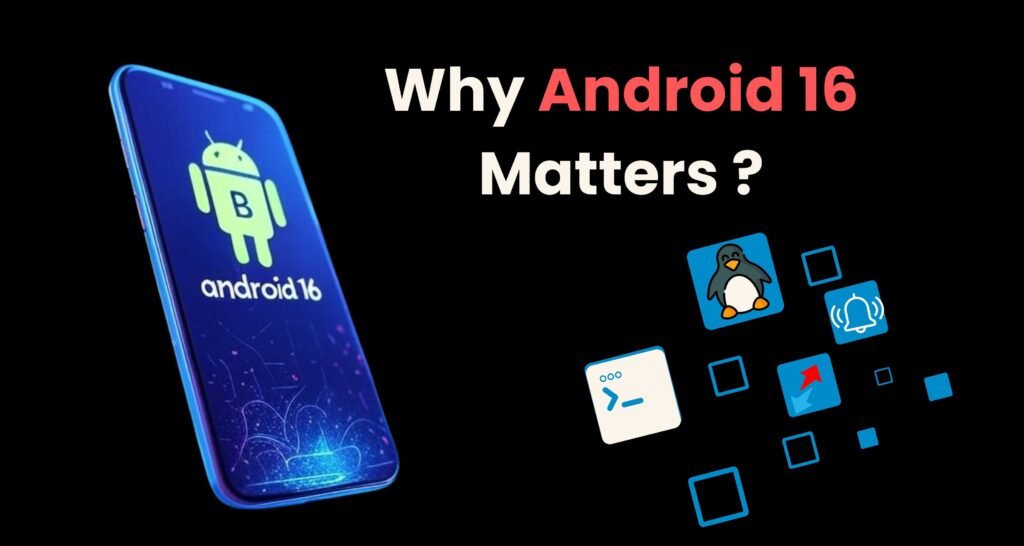Introduction: Why Android 16 Matters
Google’s Android 16 is shaping up to be one of the most significant updates in years. Slated for a June 3, 2025 release, this upgrade isn’t just about incremental tweaks—it introduces game-changing features like Live Updates, Adaptive Apps, and Linux Terminal support, making it a must-watch for developers and users alike.
But what makes Android 16 stand out from its predecessors? How will it impact daily smartphone use, app development, and even professional workflows? Let’s dive in.
Android 16 vs. Previous Versions: What’s Different?
Google has refined its release strategy with Android 16, making it faster, more developer-friendly, and packed with features like Live Updates, Adaptive Apps, APV Codec, Linux Terminal that push the boundaries of mobile computing.
Android 16 upgrades notifications, adapts apps across devices, adds pro video/Linux support, and enhances health tracking—Google’s biggest OS leap in years.
Key Improvements Over Android 15
| Feature | Android 15 | Android 16 |
|---|---|---|
| Notifications | Basic priority modes | Live Updates + Notification Cooldown |
| App Flexibility | Limited foldable support | Full Adaptive Apps |
| Multilingual Support | Standard text rendering | Vertical Text (Japanese, etc.) |
| Pro Video Support | AV1 & H.265 | APV Codec (Pro-grade video) |
| Desktop Mode | Experimental | Enhanced Desktop Mode |
Unlike past versions, Android 16 is being rolled out earlier in the year, with a more streamlined developer preview process. Google has also split the SDK into two releases, allowing developers to test behavior changes before new APIs drop.
Top Features of Android 16
1. Live Updates: Notifications That Keep Up With You
Imagine tracking your Uber, food delivery, and navigation—all in real-time without opening multiple apps. Live Updates turns notifications into dynamic widgets, letting you interact with ongoing tasks directly from the notification shade.
Why it matters: Reduces app-switching fatigue and keeps critical info at your fingertips.
2. Notification Cooldown: Fewer Distractions
Ever been bombarded by rapid-fire messages? Android 16’s Notification Cooldown temporarily lowers alert volume and minimizes interruptions if too many notifications arrive at once.
Personal take: As someone who gets Slack, email, and news alerts simultaneously, this could be a sanity-saver.
3. Adaptive Apps: One App, Any Screen
With foldables and tablets gaining traction, Android 16 pushes Adaptive Apps—software that automatically adjusts layouts for different displays. Developers can now optimize apps for:
- Foldable phones (like the Pixel Fold)
- Tablets (e.g., Samsung Galaxy Tab)
- Desktop mode (for productivity setups)
Why developers should care: This means less fragmentation and better user experiences across devices.
4. Linux Terminal: Power Users Rejoice
Android has long had terminal access, but Android 16 takes it further by letting users run GNU apps in a virtual machine. Think Python scripts, development tools, or even lightweight servers—all from your phone.
Potential use case: Developers can test code on the go without needing a laptop.
5. APV Codec: A Game-Changer for Video Pros
The Advanced Professional Video (APV) codec is built for high-bitrate recording and post-production. If you’re into mobile filmmaking, this could mean better color depth, less compression, and smoother editing in apps like DaVinci Resolve.
6. Bluetooth LE Audio Sharing (Auracast)
With Auracast, you can broadcast audio to multiple Bluetooth devices—perfect for sharing music with friends or streaming to hearing aids.
7. Health Records API
Google is expanding Health Connect with deeper medical data access. Apps can now pull records (with user permission) for fitness tracking, medication reminders, and telehealth services.
Release Timeline: When Can You Get Android 16?
- November 19, 2024 – First Developer Preview
- March 13, 2025 – Beta 3 (Platform Stability)
- June 3, 2025 – Final Stable Release
Google’s faster rollout suggests they’re aiming for better optimization and fewer last-minute bugs compared to past releases.
